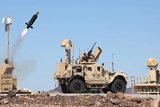Tu-160M takes off from Kazan
The first production-standard Tu-160M bomber, pictured during its first flight on 12 January. (Photo: Rostec)
The first factory-produced Tu-160M strategic bomber for the Russian Air Force took off from the airfield adjacent to the Kazan Aviation Plant on 12 January, according to Rostec.
In addition to an upgrade of the 16-aircraft Tu-160 fleet, up to 50 Tu-160M2s are planned for eventual production.
‘The 30-minute flight was at an altitude of 600 metres,’ Rostec noted in a statement. ‘The crew of Tupolev test pilots performed the required manouevres to check the aircraft stability and control.’
Compared to the baseline Soviet-era Tu-160, the upgraded Tu-160M features new avionics and control systems as well as a glass cockpit.
Upgraded and more efficient NK-32-02 engines will enable the Tu-160M and Tu-160M2 to extend their maximum range without refuelling from 14,000km to 15,000km.
Shephard Defence Insight forecasts that the first production-standard upgraded Tu-160Ms will be delivered to the Russian Aerospace Forces in 2023 at the earliest.
‘The fundamental importance of today's event is that the new aircraft has been completely rebuilt from scratch,’ Yuri Slyusar, CEO of Tupolev parent company United Aircraft Corporation, said on 12 January. ‘Its systems and equipment have been upgraded by up to 80 per cent.’
Widely regarded as the world’s largest bomber, the Tu-160M has two weapon bays that have a capacity of 45,000kg of ordnance. Since it has been in service with Russia since 2013, it is most likely the main payload will be 12 Raduga Kh-101/102 air-launched cruise missiles.
Related Programmes in Defence Insight
Related Equipment in Defence Insight
More from Air Warfare
-
![How do we detect and defeat enemy drones?]()
How do we detect and defeat enemy drones?
Learn about the portfolio of sensors and effectors for the complete counter-UAS mission at Raytheon, an RTX business.
-
![BAE Systems lauds counter-UAS drone progression with live fire trials]()
BAE Systems lauds counter-UAS drone progression with live fire trials
The US-based tests successfully demonstrated the first live trial of a precision guided missile from a modified TRV-150 drone which destroyed both aerial and ground targets.
-
![India readies private sector push as AMCA moves towards 2028 prototype]()
India readies private sector push as AMCA moves towards 2028 prototype
India’s stealth fighter ambitions gain fresh momentum as HAL opens the door to private sector involvement in AMCA Mk1A structural assembly, with strategic support growing for next-gen propulsion and sensor technologies.
-
![BAE Systems reveals new GCAP demonstrator design with plans to fly by 2027]()
BAE Systems reveals new GCAP demonstrator design with plans to fly by 2027
A key part in the trinational Global Combat Air Programme (GCAP), this is the first crewed supersonic aircraft demonstrator to be built and developed in the UK in more than 40 years.
-
![Kratos Defense makes European CCA push with Airbus partnership]()
Kratos Defense makes European CCA push with Airbus partnership
Kratos’ XQ-58A Valkyrie will be equipped with an Airbus-made mission system to be offered as a ‘European’ collaborative combat aircraft option to the German Air Force.
-
![Anduril’s Barracuda-100M completes latest successful test flights]()
Anduril’s Barracuda-100M completes latest successful test flights
The munitions variant of the Barrauda-100 autonomous air vehicle is being tested for the US Army’s High-Speed Manoeuvrable Missile (HSMM) testbed programme, with further flight tests expected in 2026.






















